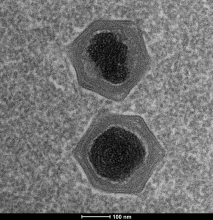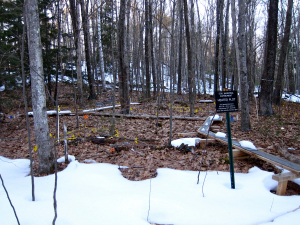You are here
16 Giant Viruses New to Science Unexpectedly Found in Harvard Forest Soils

A study released today in Nature Communications by biologists at the University of Massachusetts, the Department of Energy's Joint Genome Institute (JGI), and Stanford University reports on the discovery of 16 giant viruses never before seen by science, all found in one small soil sample in the woods at Harvard Forest.
 The soil sample - a tiny amount that could fit into a thimble - was collected in May 2017 from the Barre Woods soil warming experiment, a long-term climate study where scientists have been heating up the soils 5 degrees Celsius, year-round, since 2002.
The soil sample - a tiny amount that could fit into a thimble - was collected in May 2017 from the Barre Woods soil warming experiment, a long-term climate study where scientists have been heating up the soils 5 degrees Celsius, year-round, since 2002.
The discovery was accidental. The researchers were actually looking for bacteria, to understand how microbial communities are changing in response to warming temperatures.
Co-lead author of the study, Lauren Alteio, a PhD candidate at UMass, explained that while working with Frederik Schulz during her fellowship at the JGI, they discovered the viruses using a sequencing approach called mini-metagenomics, which until now has only been applied in aquatic environments.
Alteio says the new method may help them discover more in future samples. "Soil is immensely diverse," she notes, "and we are only beginning to scratch the surface of the organisms and viruses that inhabit it." This study marks the first discovery of giant viruses from a terrestrial environment.
Jeff Blanchard, UMass biology professor and longtime Harvard Forest research affiliate who oversaw the work, says the massive genomes of the giant viruses stood out next to surrounding organisms as if they were Macy's day parade balloons. Several of the new viruses found by the team have the largest virus genomes ever recorded.
The scientists gave the new viruses names that reflect their forest origins, such as "Dasovirus" (Greek "daso" for forest), and "Solumvirus" (Latin "solum" for soil). They also propose naming one "Harvfovirus" to honor Harvard Forest.
The study was funded by the US Department of Energy and the National Science Foundation.
- Read the Dept. of Energy press release and the UMass press release.
- Browse articles in the Boston Globe, the Worcester Telegram, LTER News, and New England Public Radio.
- Read the full paper in Nature Communications: Hidden diversity of soil giant viruses
(Title photo, a micrograph of Cafeteria roenbergensis virus -- CroV, the closest relative of the Faunuvirus discovered at Harvard Forest -- by Ulrike Mersdorf & Matthias Fischer at the Max Planck Institute for Medical Research.)

